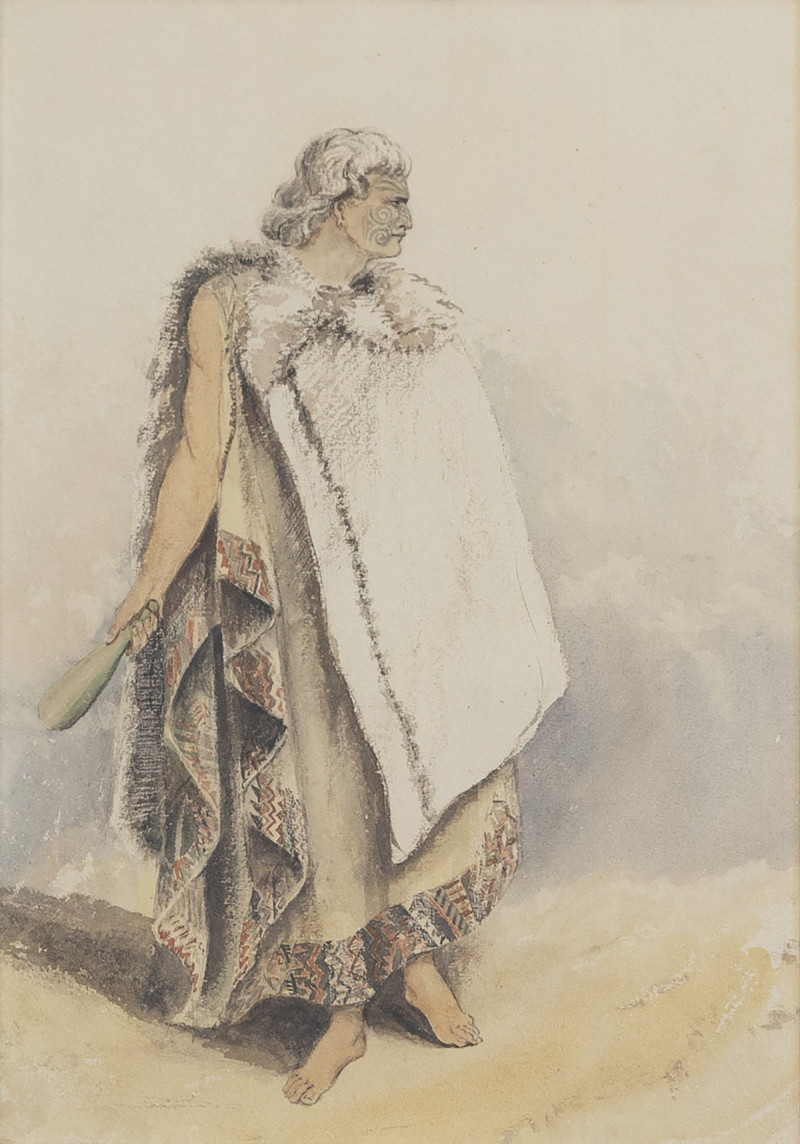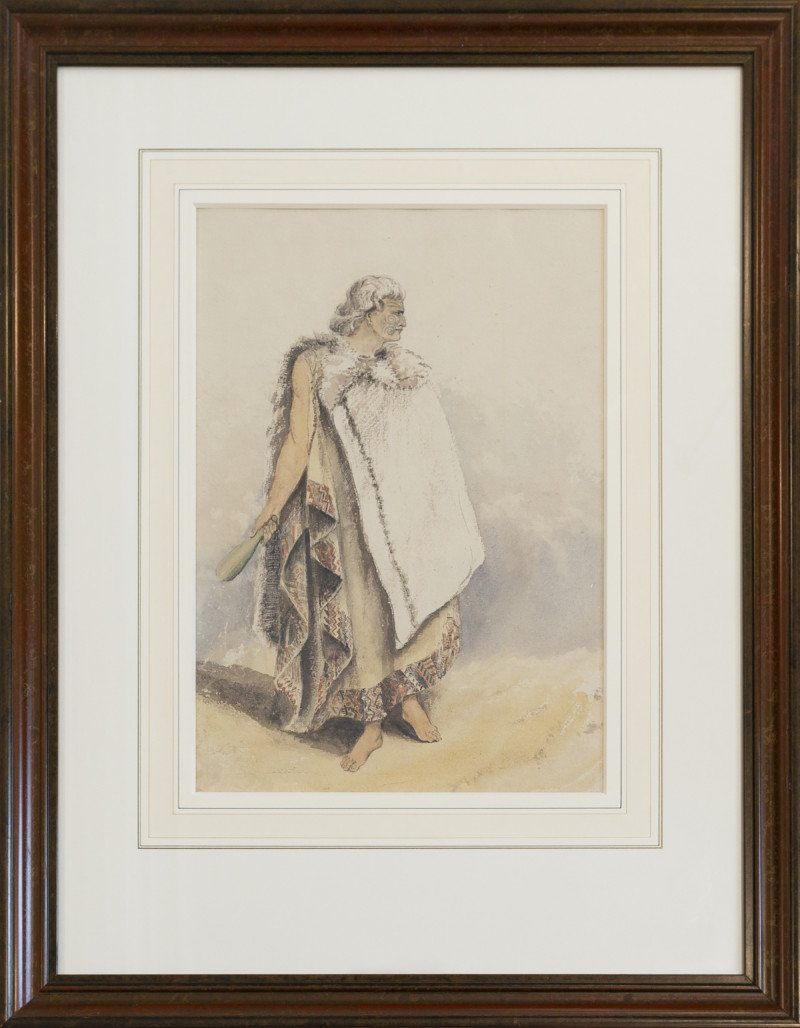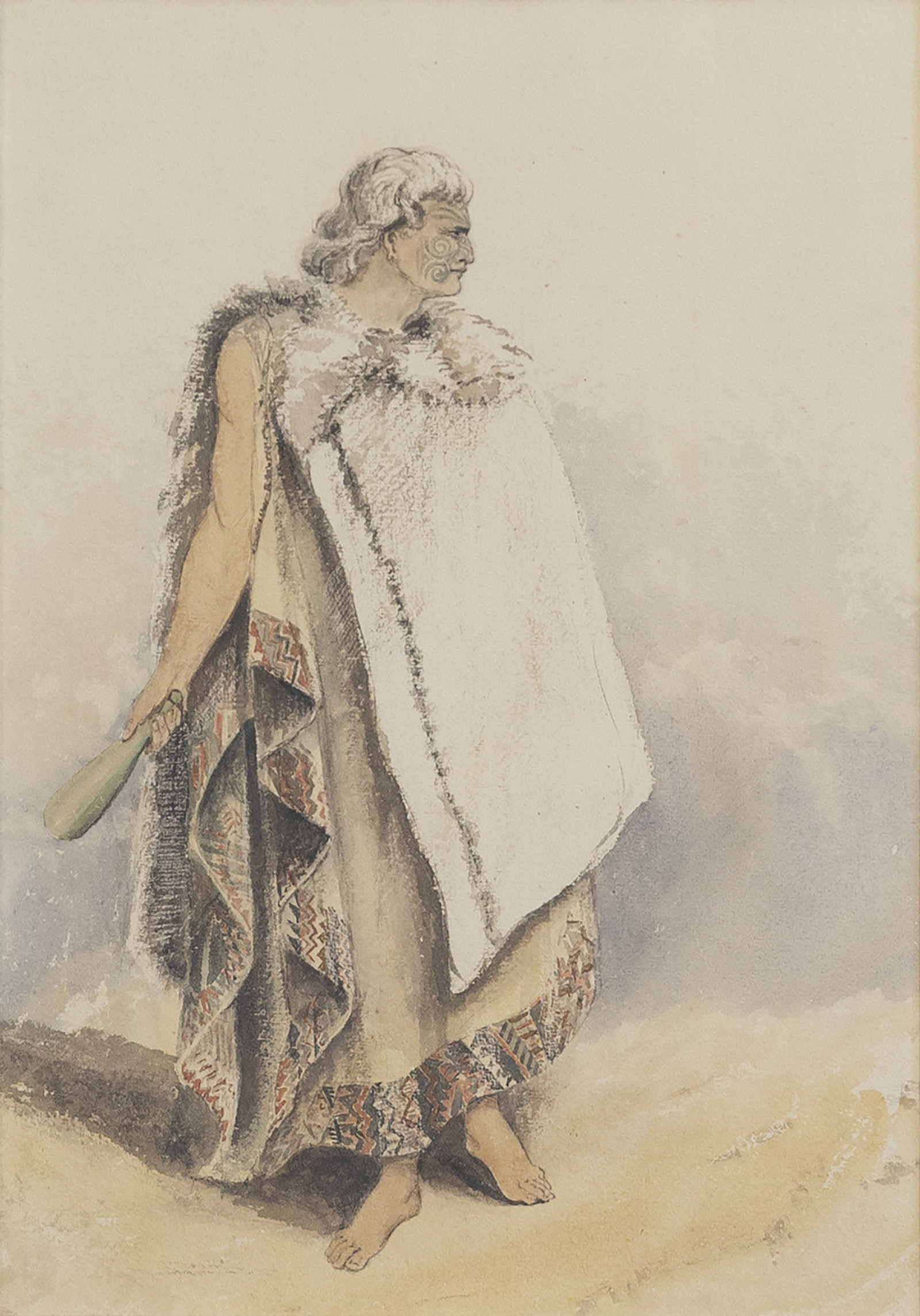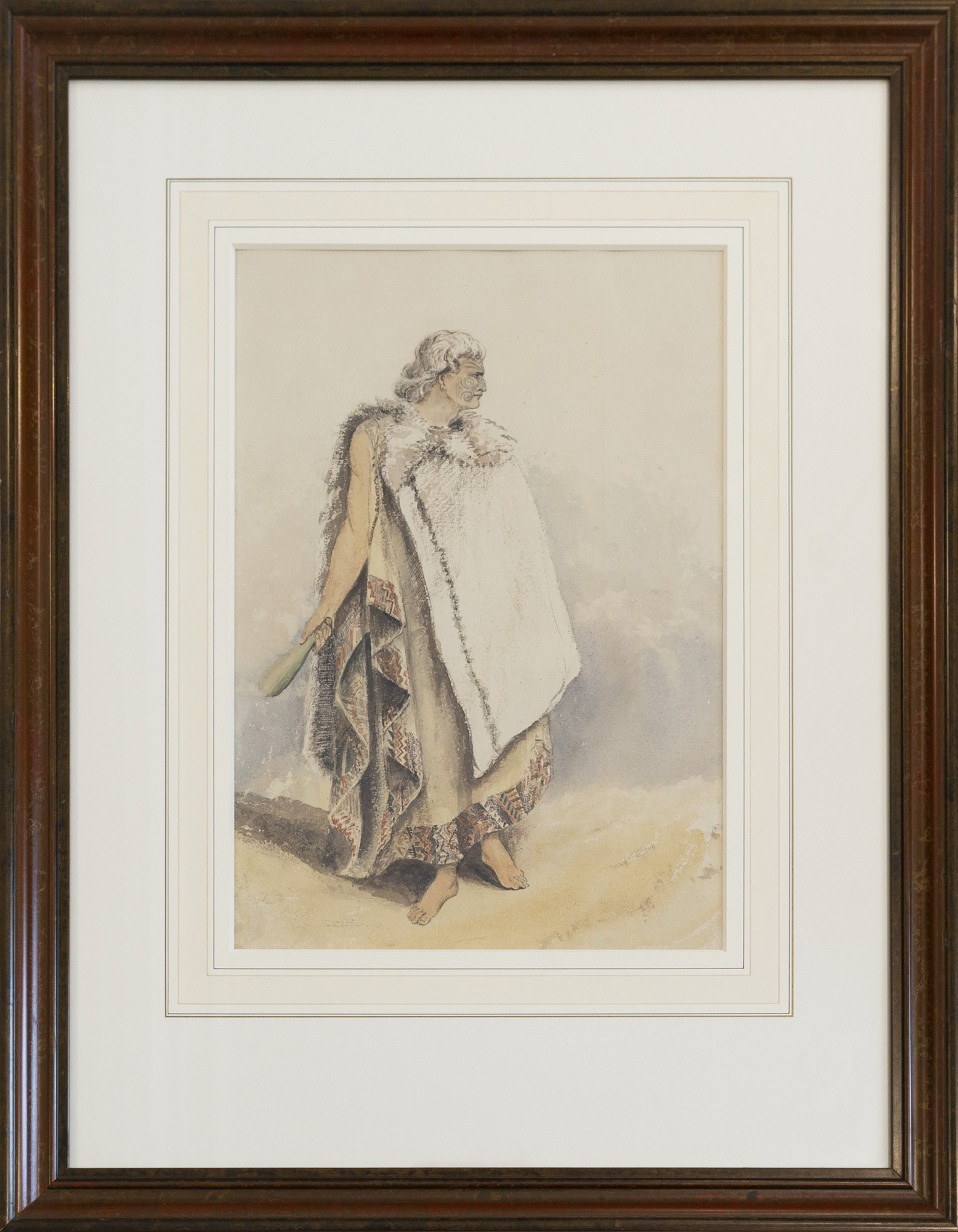OLIVER, Richard Aldworth;
Te Rangihaeata, Chief of Ngāti Toa
c.1850
Watercolour on paper
470 x 325mm (image); 815 x 635mm (frame)


A biography of Te Rangihaeata is available on Te Ara The Encyclopedia of New Zealand.
Captain R. A. Oliver was stationed in Aotearoa between April 1848 and August 1851 in command of the 18-gun naval sloop HMS Fly. He carried out surveys in New Zealand waters, transporting Governor Grey around the country and providing a military presence when reports of Māori–Pākehā disagreements were received. He came from a naval family (his father was an admiral) and entered the navy while in his teens, rising to become an admiral himself at the end of his career.
In 1852, he published A Series of Lithographic Drawings from Sketches in New Zealand, a folio volume containing eight hand-coloured lithographs. This watercolour portrait of Te Rangihaeata formed the basis of the first plate in the volume. Oliver probably received training in drawing with pencil and watercolour as part of his naval education. He particularly favoured portraits of Māori subjects and interiors of pā. In his private journal, he commented on the beauty and dignity of Te Rangihaeata in his native dress, adding, ‘There is no one with the least feeling for the Picturesque who would not lament the change in the native costume.’
The letterpress associated with the volume of lithographs indicates that Te Rangihaeata’s name may be translated ‘The Heavenly Dawn’. Oliver described him as being ‘from both descent and energy of character the most influential native in the Southern district of New Zealand … Te Rangihaeata had not embraced Christianity up to the point of my departure and still affected to despise the Manners, Customs, Arts and Religion of the Pakehas.’
Te Rangihaeata was born probably in the 1780s in the Kāwhia district. His youth was dominated by a struggle between the people of Kāwhia and other Waikato districts for control of the fertile and sparsely populated coastland north of Kāwhia towards Whaingaroa (Raglan). In 1819, already regarded as a war leader, Te Rangihaeata joined Te Rauparaha on a joint war expedition with Northern tribes through Taranaki, Whanganui, the Kāpiti Coast, Te Whanganui-a-Tara (Wellington) and Southern Wairarapa.
During a period of months, they killed and captured many people, eventually returning to Kāwhia, having cemented alliances with their opponents—Te Rangihaeata himself marrying Te Pikinga, sister of the captured Ngāti Apa chief Te Arapata Hiria. By 1821, both chiefs had suffered serious defeats from Waikato tribes and Te Rangihaeata agreed to accompany Te Rauparaha on the migration Te Heke Tahutahuahi to the Kāpiti coast.
In 1822, Te Rangihaeata helped defeat the pursuing Waikato tribes at Motunui. About 1824, Te Rangihaeata and Te Rauparaha successfully defended their people against a concerted attack on Kāpiti by their enemies, thus inaugurating seven years of struggle between Ngāti Toa and local tribes. Shortly after this, both chiefs became involved in a feud with Southern tribes that resulted in their devastation of the Kaikōura coast and later Kaiapoi.
In the early 1830s, Te Rangihaeata probably took part in the three separate campaigns against Kāi Tahu. In the 1830s, he lived on Mana Island, spent time on Kāpiti, and visited the mainland, where he had cultivations at Taupō, Porirua. A small whaling station was established at Mana Island with his permission, although Te Rangihaeata was both feared and disliked by the whalers for his exacting of tribute in the form of gifts. Europeans who encountered him regarded him as Te Rauparaha’s lieutenant, Te Rauparaha being credited with the greater cunning and Te Rangihaeata with ferocity.
In October 1839, with the arrival of the New Zealand Company ship Tory, Edward Gibbon Wakefield sought to purchase land on the Kāpiti coast for European settlement. He induced Te Rangihaeata to sign a deed purporting to purchase all his rights and claims on both sides of the Tasman. Te Rangihaeata intended only to grant Europeans rights to certain areas. Later, this deed was invalidated as being inadequately translated and too sweeping in its description of what had been purchased.
On 19 June 1840, Te Rangihaeata signed the Treaty of Waitangi on board the Herald. He probably intended to do no more than accept the Governor’s authority to rule over the turbulent whalers and keep the company settlers in check. Gradually, he learned that in European terms land purchase meant permanent alienation of land and that his signature on the Treaty had transferred much more than ‘kāwanatanga’ to Queen Victoria. He travelled about encouraging objections to proposed land sales; he ordered followers to destroy bridges and block routes preventing surveys; many settlers blamed him for their troubles and demanded his arrest.
Both Te Rangihaeata and Te Rauparaha had consistently denied that the Wairau Valley had ever been sold. After they burned a surveyors’ hut, which had been erected on the land, they faced charges of arson and were on the point of arrest by a force of 47 special constables when a stray shot killed Te Rangihaeata’s wife Te Rongo as she sat by a fire. Firing broke out and nine Europeans were taken prisoner.
Te Rauparaha spoke against killing them, but Te Rangihaeata silently moved behind each prisoner and clubbed them to death. Furious settlers demanded his arrest and execution, but Governor FitzRoy rebuked the Nelson magistrates who issued the warrants, explaining that persons who burnt their own property could not be charged with arson and affirming that indeed the Wairau Valley had never been purchased.
Te Rangihaeata also opposed the settlement of Hutt Valley by Europeans, claiming that it, too, had not been paid for. Coolness developed between Te Rauparaha and Te Rangihaeata after Te Rauparaha had offered to give up the Hutt without Te Rangihaeata’s agreement. Māori refused to leave and Europeans constructed forts; Te Rangihaeata camped in the Upper Hutt Valley with more than 500 followers. Agreements made with Sir George Grey in 1846 were subsequently disrupted when settlers looted Māori houses, their church, and plantations. Although Te Rangihaeata never attacked in revenge, he did build a new pā at Pāuatahanui, which was itself never attacked out of fear that Te Rauparaha might abandon his neutrality.
Eventually, Te Rauparaha was captured and a force moved against Pāuatahanui, but Te Rangihaeata retreated to another fortification. After several clashes, his followers dispersed to settle on the south coast of Manawatū. Here, despite pleas for assistance from Māori allies, his people suffered from starvation. In 1847, he asserted his power by raiding Kāpiti and imposing tolls on settlers using the Foxton–Levin road. He was induced by the missionary Octavius Hadfield to consent to the sale of the Rangitikei block and thereafter ceased active opposition to European expansion. He visited Ōtaki to farewell Governor Grey in 1853 and attended church without ever becoming Christian.
Te Rangihaeata died on 18 November 1855 as the result of pneumonia after lying in a stream to reduce a fever caused by measles. He was thought to be in his early 70s. He was buried at Poroutawhao beside his wife Te Pikinga.
Exhibition History
Gathered Voices: Highlights from the Fletcher Trust Collection, New Zealand Portrait Gallery Te Pūkenga Whakaata, Te Whanganui-a-Tara, 15 September to 11 December 2022 (toured)
Te Huringa/Turning Points: Pākehā Colonisation and Māori Empowerment, Sarjeant Gallery Te Whare o Rehua, Whanganui, 8 April to 16 July 2006 (toured)
Provenance
1994–
Fletcher Trust Collection, purchased September 1994
–1994
Unknown


